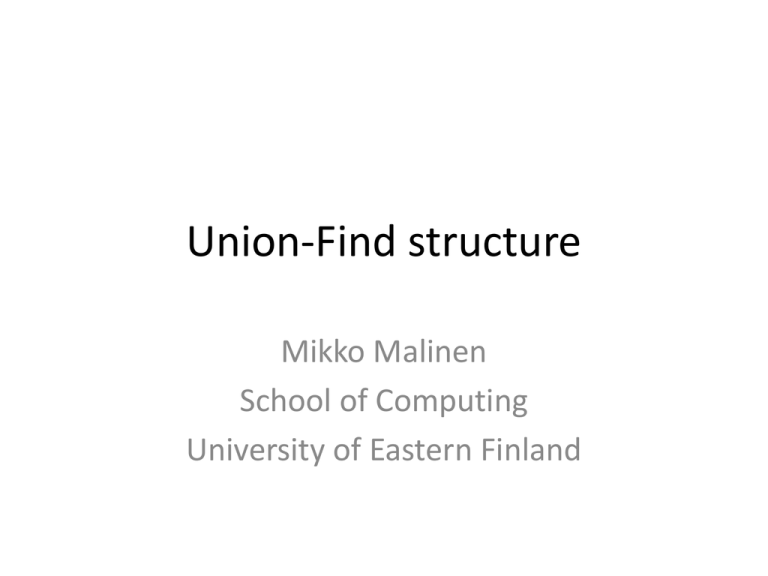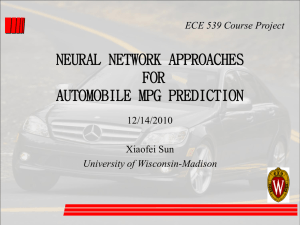Union-find (by M.I.Malinen)
advertisement

Union-Find structure
Mikko Malinen
School of Computing
University of Eastern Finland
Basic set operations
find(a)
union(S1 , S2 , S )
m em ber(a, S )
add(a, S )
remove(a, S )
min(S )
Given several sets. Find the one,
where a belongs.
Form union S : S S of sets S1 and S2 .
Usually supposed that S1 S2 .
Does element a belong to set S .
Add element a to set S . S : S {a} .
Remove element a from set S if it is
in that set.
Suppose that set S is linearly ordered.
Find the smallest element of set S .
1
2
Union-Find structure
• An abstract data type
type set(T) has
procedure createset(x: T) returns set
procedure findset(x: T) returns set
procedure union(S1,S2: set) returns set
• createset(x) forms a set consisting of one
element {x}
• findset(x) returns the set where x belongs
• union(S1,S2) forms the union of the sets S1
and S2.
• In union-operation the sets S1 and S2 are
destroyed. So no element can belong to more
than one set.
• We are interested in a task, which consists of a
sequence of operations createset, union and
findset.
Trivial solution
Represeting a set by a list
• A B can be formed in constant time by
combining the lists
• findset O(n), when there are n elements
Copyright © The McGraw-Hill Companies, Inc. Permission required for reproduction or display.
Trivial solution
Representing a set by a bit vector
• Let U be an ordered base set and |U| = n
• Representing subset S U as an n-bit vector
vs : vs ’s i:th bit is 1, if U’s i:th element belongs to S.
• Union can be implemented as bit vector operations
(in one step, if n is not too big); rquires time O(|U|)
and each set requires space O(|U|).
• Findset requires time O(n).
Trivial solution
Representing a set as a table
• union requires time O(n)
• findset can be implemented in constant time,
if elements have order, otherwise O(n)
Tree representation
• Sets are represented by a forest (a single set is
represented as a tree)
• We choose the root node of a tree to be the
representative of the set
• if vertex x is the root of the tree T, then by
notation [x] we mean the set formed be the
vertices of the tree T.
Copyright © The McGraw-Hill Companies, Inc. Permission required for reproduction or display.
Tree implementation
• Operation makeset(x) forms a tree, the only
vertex will be the root x
• In operation findset(x) a path is followed from
vertex x upwards until the root y is reached.
Then [y] is the result.
• Operation union([x],[y]) is implemented by
setting vertex x as a child of vertex y. Then [y]
is the union set.
• Problem: the tree may come inbalanced
Solutions to inbalanced trees
Solution 1: Balancing. In operation union([x],[y])
the new root will be that element x or y, of
which tree is highest.
Solution 2: Path compression. When a root y has
been found as a result of operation findset(x),
the father of all the vertices in the path leading
from x to y will be set y.
Copyright © The McGraw-Hill Companies, Inc. Permission required for reproduction or display.
Time complexity
• We examine an operation sequence, where there
are n makeset-operations and m findset
–operations
• New elements are created only with makeset
operation, so n is the number of elements and n1 is an upper bound for union-operations.
• In spite of balancing, a tree may be formed, of
which height is log n. If we estimate all find operations this difficult, the whole task would
require time O(m log n). This estimate is too
pessimistic.
Time complexity
• A more accurate analysis is based on the idea
of balancing the costs
• Let A be Ackerman function and (m, n) its
one kind of inverse function
• (m, n) grows extremely slowly. (m, n) <= 3
with all thinkable values of arguments m and
n.
• If union-find task has n union- and m findset
-operations, it can be executed in time
O(n m (m, n)) . (proof omitted).
Applications
Copyright © The McGraw-Hill Companies, Inc. Permission required for reproduction or display.
Copyright © The McGraw-Hill Companies, Inc. Permission required for reproduction or display.
PNN Clustering
Pseudo code
PNN(X, M) C, P
si {xi} i[1,N];
m N;
REPEAT
(sa, sb) NearestClusters();
MergeClusters(sa, sb);
m m-1;
UpdateDataStructures();
UNTIL m=M;
Example of the overall process
M=5000
M=50
M=16
M=15
M=5000
M=4999
M=4998
.
.
.
M=50
.
.
M=16
M=15
Detailed example of the process
Example - 25 Clusters
MSE ≈ 1.01*109
Example - 24 Clusters
MSE ≈ 1.03*109
Example - 23 Clusters
MSE ≈ 1.06*109
Example - 22 Clusters
MSE ≈ 1.09*109
Example - 21 Clusters
MSE ≈ 1.12*109
Example - 20 Clusters
MSE ≈ 1.16*109
Example - 19 Clusters
MSE ≈ 1.19*109
Example - 18 Clusters
MSE ≈ 1.23*109
Example - 17 Clusters
MSE ≈ 1.26*109
Example - 16 Clusters
MSE ≈ 1.34*109
Example - 15 Clusters
MSE ≈ 1.34*109
Revised PNN algorithm
P NN( X , M ) C , P
si {xi } i [1, N ];
MAKESET (xi ) i [1, N ];
O(N )
m N;
REP EAT
( sa , sb ) NearestClusters();
MergeClusters(sa , sb );
m m 1;
UpdateDataSt ructures();
UNION(sa , s b );
O(1)
UNT ILm M ;
if FINDSET (x3 ) FINDSET (x78 ) P RINT ("same");
Revised PNN algorithm
• Complexity of Union-Find program O(n m (m, n))
where n is the number of union operations
and m is the number of findset operations
• Traditional partitioning takes time T=NM
• To query in Revised PNN algorithm is fast,
when the number of queries is low









